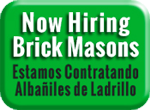Chimney Damage Caused by Freeze-Thaw
For the same reason tarps are used to cover some outdoor plants in freezing temperatures, it is important to keep an eye on possible chimney damage caused by freeze-thaw cycles. Preventing moisture intrusion in chimney masonry is a task worthy of year-round attention, and the primary reason is what happens in winter. When you understand how destructive the elements can be, prioritizing routine chimney inspections makes more sense. Homeowners in Richmond VA and the surrounding area save money by avoiding the chimney damage caused by freezing and thawing cycles.
 How are Chimneys Damaged by Icy Weather Conditions?
How are Chimneys Damaged by Icy Weather Conditions?
Since last winter, if moisture has seeped into your chimney masonry, a destructive process will occur with every wintry freeze-thaw cycle. The water within the bricks expands when it freezes and contracts when the ice melts. This movement breaks down the internal structure of any brick that contains moisture. When this happens, the only way to avoid a leaning, teetering chimney in danger of collapse is to remove and replace the affected bricks.
How to Prevent Water Intrusion in Chimney Masonry
Different components of correctly constructed chimneys contribute to the constant battle of keeping moisture out of the masonry system. You can add an extra layer of protection by scheduling waterproofing services from trusted chimney pros like the certified chimney sweeps at Chimney Saver Solutions.
If you keep a vigilant watch on signs that your chimney needs repair, it is possible to prevent the destruction directly resulting from water intrusion. The following are signs that repair or intervention is needed, though such signs need to be recognized as early as possible to avoid moisture in the masonry system:
- Cracked, crumbling mortar
- Cracks in the chimney crown
- Rain or melting snow creates a deluge against the chimney
- The metal flashing is rusted or has pulled away from the chimney
Signs of Moisture in Chimney Masonry
Signs you can watch for provide proof that moisture has already entered the masonry system. A partial or complete chimney masonry rebuild is either certainly or most likely needed when you see the following:
White Staining aka Efflorescence
Known as “efflorescence,” white staining on chimneys occurs when water-compromised masonry contains water-soluble salt. Once moisture has seeped in, it travels through the masonry and leaves salt deposits on the brick face.
Spalling
The destructive process caused by freeze-thaw cycles in winter is evident when spalling occurs. The brick face of damaged masonry flakes and breaks off. Bits of masonry debris around your chimney or on the ground below are signs of spalling.
Water Stains on Walls or Ceilings
If you ever see water stains on your interior walls or ceilings near the chimney, it is almost certain that water has infiltrated your chimney masonry system. Schedule chimney masonry repair as soon as possible.
Flue Tile Debris in the Firebox
A mix of moisture and creosote in chimney liners has a destructive effect on flue tiles. If you see bits of broken flue tiles in your firebox, it likely means water is in the masonry. Debris is, however, a sure sign that flue liner repair or replacement is required to use your fireplace safely.
Rusted Chimney Components
If your chimney damper or fireplace grate becomes rusted, it is likely because of a leaky chimney due to moisture damage.
 Contact Chimney Saver Solutions
Contact Chimney Saver Solutions
Our CSIA-certified chimney experts at Chimney Saver Solutions can help prevent and repair chimney masonry damage caused by freeze-thaw cycles.
We are at 9306 Old Staples Mill Rd in Richmond VA. Schedule an appointment today by filling out our contact form or calling 804-440-5000.






